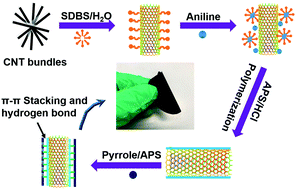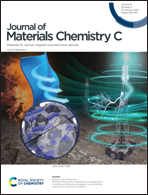Enhanced thermoelectric properties of polyaniline/polypyrrole/carbon nanotube ternary composites by treatment with a secondary dopant using ferric chloride†
Abstract
Polymer/carbon nanotube (CNT) composites have lower electrical conductivity than pristine CNTs since the carrier barriers at the interface between the polymer and CNTs hinder the carrier pathways from tube to tube. Herein, polyaniline/polypyrrole/single wall carbon nanotube (SWCNT) ternary composites were fabricated by an in situ method. Ferric chloride (FeCl3) was applied as a secondary dopant to further improve the electrical conductivity and the power factors of ternary composites. The electrical conductivity of the composite after FeCl3 doping was 2.9 times higher than that of the composite before FeCl3 doping, increasing the power factor by 2 fold. Scanning electronic microscopy (SEM) images, X-ray diffraction (XRD) patterns, Raman spectra and Fourier transform infrared spectra were used to characterize the properties of the ternary composites. The highest power factor was 19.2 μW m−1 K−2. The results demonstrate that using FeCl3 as a secondary dopant to further dope polymer/SWCNT composites is a good strategy to enhance the thermoelectric properties of polymer/SWCNT composites.



 Please wait while we load your content...
Please wait while we load your content...